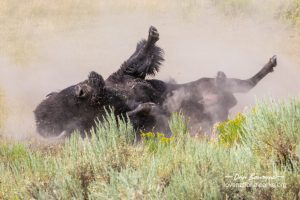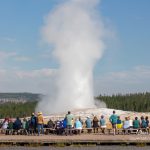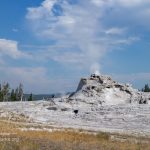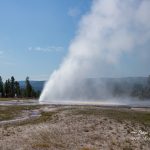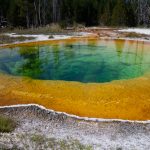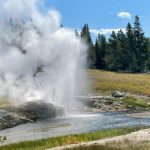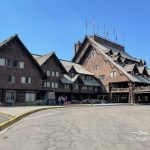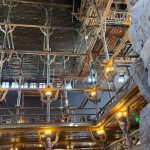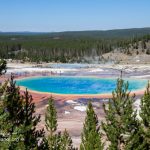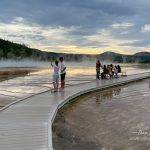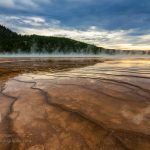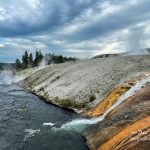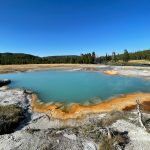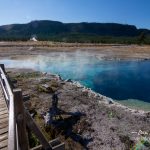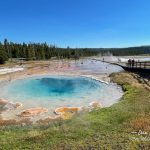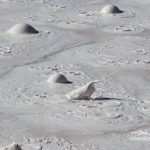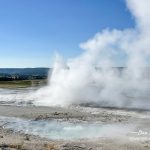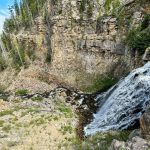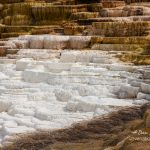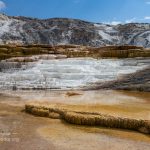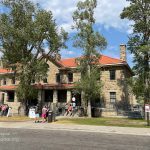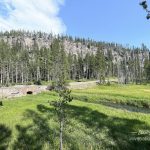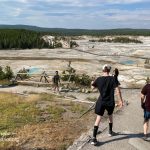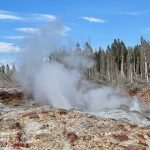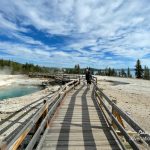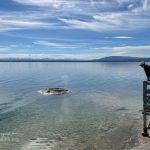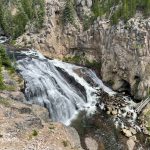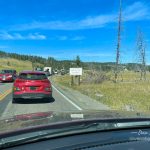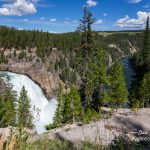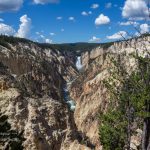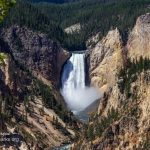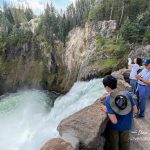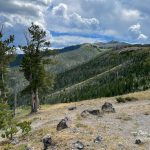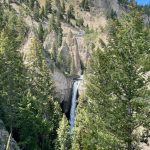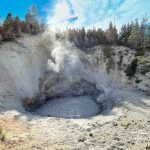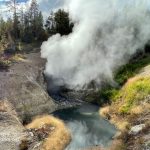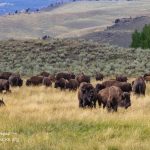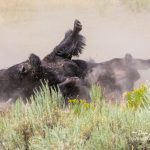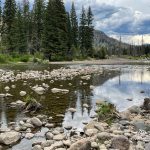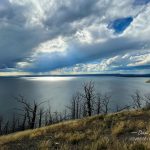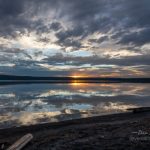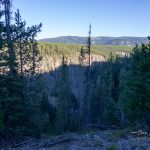
 Yellowstone National Park, Wyoming, was founded in 1872 as the first National Park. Why a National Park? Because Wyoming and Montana weren’t states yet! But what a great place to start the National Park concept, the first of its kind in the world. Yellowstone is unique as the home of the world’s largest concentration of geysers, bubbling mud pots and other geothermal phenomenon.
Yellowstone National Park, Wyoming, was founded in 1872 as the first National Park. Why a National Park? Because Wyoming and Montana weren’t states yet! But what a great place to start the National Park concept, the first of its kind in the world. Yellowstone is unique as the home of the world’s largest concentration of geysers, bubbling mud pots and other geothermal phenomenon.
Visitor Rating (write your own review below)
Fun for All
![]() Scenery
Scenery
![]() Uniqueness
Uniqueness
![]() Wildlife
Wildlife
![]() Diversity
Diversity

One of the “scheduled” geysers in the Upper Geyser Basin is Riverside Geyser on the edge of the Firehole River. It’s well worth watching, especially since it erupts for around 20 minutes at a shot and is one of the more scenic geyser locations
ILNP Park Review
In a Word. “Delightful”
“Tremble, O earth, at the presence of the Lord, at the presence of the God of Jacob, who turned the rock into a pool, the hard rock into springs of water.” -Psalms 114:7-8
Our Visit. We’ve visited Yellowstone twice. Once in July many years ago and once more recently in August. For the first trip, we stayed in a cabin in Victor, Idaho to save money, but the most recent trip we stayed in Grand Teton National Park which made the “commute” to Yellowstone much shorter.
Our Weather. Couldn’t have been more beautiful for both trips! Partly cloudy skies and highs in the 80s (July) and 70s (August) except for one evening with heavy clouds and a little rain.
Overall Impression. Yellowstone is one of the most amazing places on earth, and you need to see it with your own eyes. Nowhere else can you find the concentration of geothermal phenomenon that exists in this small corner of the world. Every day, all day long, Yellowstone’s delightful geysers put on a show more incredible than anything manmade. If this weren’t enough, there are enough bison (and sometimes bear) to ensure everyone can get see some big wildlife. The days you spend in Yellowstone will make you beam contently for weeks and leave you waiting to return someday.
Favorite Spot. Upper Geyser Basin
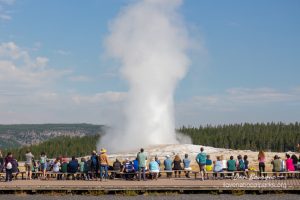
Here it is, the star of the park, Old Faithful Geyser. It’s one of the things you simply must see if you’re there (it erupts approximately every 90 minutes), but the ever-present crowd distracts a bit from its beauty
Minimum Time Required. In about 4 hours, you can drive a quick loop through the park and stop for a couple of sights along the road, but having only 4 hours would be tragic. If you only stop one place, make it the Upper Geyser Basin, home to Old Faithful, the Old Faithful Lodge and several beautiful thermal pools. While this is the most commercial area of the park, it’s at the top of the list for a reason, and Old Faithful still brings the most predictable and frequent major eruptions in the park. Make a quick stop in the Old Faithful Visitor Center to see the schedule for the handful of predictable geyser eruptions and plan your time accordingly. While you’re there, take a quick swing by Old Faithful Inn and see one of the most amazing log interiors you’ll ever see. A walk around the Upper Geyser Basin via the boardwalk will take about an hour, and if you’re lucky, you’ll be able to see some of the other predictable geysers like Daisy Geyser, Lakeside Geyser, and even Giant Geyser.

The Fountain Paint Pots in the Lower Geyser Basin are fun to watch–it looks like boiling pudding, and the popping bubbles take on many shapes
A Longer Visit. We would recommend two days minimum. Even in two-and-a-half days we weren’t able to see everything. If you’re visiting both Grand Teton and Yellowstone, I’d say Grand Teton is more about hiking to and around beautiful sites while in Yellowstone its about driving to the unique sites and taking short hikes on the boardwalks, so plan on spending most of your days in the car between sites.
Yellowstone can be divided into major areas where you can spend 2-4 hours, and you can build your days to suit your preferences. Travel time between areas is anywhere from 20-90 minutes, so figure roughly 1 hour travel time between areas. Here’s how we would classify the different major areas and in our recommended priority order:
- Old Faithful and Upper Geyser Basin. This area, described above, includes Old Faithful Inn and the many pools and geysers near the boardwalk as well as a few short trails to overlooks and more remote geothermal features. Budget 2-4 hours. This is the heart of the park!
-

To really see the colors of Grand Prismatic Spring, you need a bit of elevation. The trail to Fairy Falls provides such a vista with a moderate 1.5 mile round-trip hike
Grand Prismatic Spring and Midway Geyser Basin. This area includes the Grand Prismatic Spring, Fairy Falls Trail to the Grand Prismatic Spring Overlook, and Firehole Lake Drive. The focus here is on the “must see” largest and most colorful pool in the park. Budget 1-4 hours depending on how far you want to hike.
- Grand Canyon of the Yellowstone and Hayden Valley. This area of the park is focused on natural beauty and wildlife rather than geothermal activity, so if huge waterfalls and bison are more your thing, make sure to add this area! Budget 1-3 hours.
- Mammoth Hot Springs. This area has very different geothermal features from the geyser basins and also offers the best glimpse into the early days of Yellowstone as a National Park. Boardwalk trails with lots of steps and historic buildings dominate this area. Budget 1-3 hours.
- Tower-Roosevelt. This area in the northeast portion of the park is a great place to see wildlife (Lamar Valley), see great panoramic views (Mt Washburn), and it has some lesser visited treasures such as Tower Falls and Petrified Tree. Budget 1-3 hours.
- Norris Geyser Basin. A large and active geyser basin in its own right, but home to mainly smaller geysers and pools… unless you happen to catch a rare eruption of Steamboat Geyser, the tallest in the park. Budget 1-2 hours.
Additionally, there are many minor areas which take between 15-45 minutes to visit which can be added along the drive as time permits in our rough priority order:
- Lower Geyser Basin. The Fountain Paint Pots Trail is the best way to visit, and it’s a miniature microcosm of geothermal features with pools, geysers, fumaroles and paint pots all in close proximity.
-
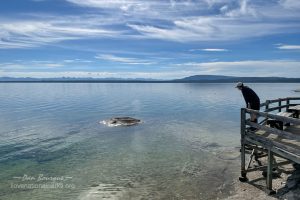
One of the more unique geothermal features is Fishing Cone in West Thumb Geyser Basin which rises up from Yellowstone Lake
West Thumb Geyser Basin. Another compact area with tightly grouped pools, paint pots and geysers along the shore of Yellowstone Lake. It’s beautiful here, but the geysers are less active.
- Gibbon Falls. This is a good stop between Madison and Norris for a great view of a beautiful little canyon and sprawling falls.
- Artists Paint Pots. It takes a while to hike to the paint pots, but this is the best collection of these features in the park.
- Fishing Bridge. Not far from this area you’ll find a great overlook of Lake Yellowstone (Lake Butte Overlook) and some neat geothermal features in the Mud Volcano area. It’s a good stop for those heading north to the Canyon and Tower areas.
Here’s how we spent our 2 1/2 days. We wanted to save Old Faithful for a full day, so on our first half day (we hiked at Grand Teton in the morning), we chose the popular hike up Fairy Falls Trail to the Grand Prismatic Spring overlook where you can really see the color of this iconic pool. We wanted to take Firehole Lake Drive, but unfortunately it was closed both times we tried, so we visited Biscuit Basin and the Fountain Paint Pots Trail, both shorter boardwalk hikes but well worth a stop.
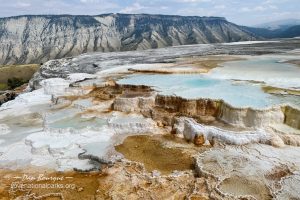
One of the neatest views in the Mammoth Hot Springs area is that of New Blue Spring from the boardwalk near the Upper Terrace Area–this view lets you see the beautiful turquoise water that sits atop the white and orange formations
On our full days, we did a “west day” and an “east day” from the South Entrance Station, and it worked well. On the “west day,” we started early and got to the Old Faithful area before the crowds got bad. We were able to see three of four “scheduled” geysers (all but Giant Geyser) along the boardwalk in about a 90 minute window along with sights like Morning Glory Pool, Castle Geyser and Grotto Geyser. From there, we headed north toward Mammoth Hot Springs stopping at Gibbon Falls along the way. At Mammoth Hot Springs, we took the Upper Terrace Drive and got out on the boardwalk to see New Blue Spring and Mound Spring before heading to the Lower Terrace and Palette Spring. We spent some time walking around the Albright Visitor Center and museum in Fort Yellowstone to learn more of Yellowstone’s history and took advantage of the nearby stores and food. On the way back south, we had some time left to visit Norris Geyser Basin with short hikes to Steamboat Geyser and Porcelain Basin.
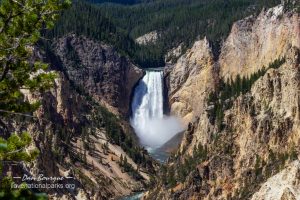
There are amazing views of the Grand Canyon of the Yellowstone and both Upper and Lower Falls along the north and south rims, but we preferred the south rim including this zoomed in shot from Artists Point
On the “east day,” we started with a quick visit to West Thumb Geyser Basin and its short boardwalk overlooking Yellowstone Lake and sights like Fishing Cone. After driving along the shore of the lake, we took the road from Fishing Bridge to Canyon Village stopping at some pull-outs in Hayden Valley to look for wildlife (the bison can be seen any time of day and we spent 15 minutes waiting for a “bison jam” to clear). We spent a couple hours around the Grand Canyon of the Yellowstone. We recommend the South Rim Drive and especially Artists Point. On the north side, we took the short hikes to the Brink of the Upper Falls and picked a couple vistas along North Rim Drive to see additional views of the canyon the Lower Falls. If you’re up to it, the Brink of the Lower Falls is spectacular but requires several hundred vertical feet of hiking. If you’re pressed for time, we found Inspiration Point to be less inspiring than Artists Point. Continuing north toward Tower, our road wound up and over the hills offering great views in all directions. With additional time, we would have hiked Mt Washburn, a park favorite for its views. The General Store before you get to Tower-Roosevelt is also the trailhead for a short trail to see the tall and narrow Tower Falls, and its worth the few minutes it takes to make the hike. At Towers, we took the road to the Northeast Entrance through the Lamar Valley which is a great spot to see bison up close (all the bison photos on this page are from this area). If you don’t spot the bison along the main road, try the easy gravel road up to Slough Creek. On the way back, we took a few minutes to stop at Mud Volcano–the nearby Dragon Mouth Spring lives up to its name and is worth the stop. If vistas are your thing, take a jaunt down the East Entrance Road past Fishing Bridge as far as Lake Butte Overlook where you can get a panoramic view of the enormous Yellowstone Lake. We ended the day by visiting Grand Prismatic Spring who’s always full parking area was now mostly vacant, and we took a brief jaunt around Black Sand Basin to cap things off.
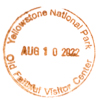 With more time, you can take some longer hikes or take one of many guided tours available. While these guided tours may cover some of the same ground you’ve already covered, you’ll learn a lot more about the history and geology of the area.
With more time, you can take some longer hikes or take one of many guided tours available. While these guided tours may cover some of the same ground you’ve already covered, you’ll learn a lot more about the history and geology of the area.
Suggestions. The road gets you NEAR the great sites, but to really see the wonders of Yellowstone, you have to hike just a little. The hikes are short, not too challenging and very rewarding. While the geysers get the glory, the multitude of pools are worth seeing up close–it’s amazing how much variety they have in shape, color, clarity and activity, and two adjacent pools can be completely different. One note about the geothermal features–they are extremely delicate! Today’s Park management does a good job of warning visitors of the delicate nature of the pools and geysers and strictly prohibits any foreign objects from being thrown into the pools and geysers. For some areas, it’s a little too late. For example, the Minute Geyser in the Norris Geyser Basin used to erupt every 60 seconds until some visitors threw debris into its vent decades ago; now it just sits and sputters. Also, the Morning Glory Pool, arguably the most beautiful in the Park, is cooling and changing colors gradually because its throat has become partially blocked with coins and other debris thrown in by ignorant visitors. Don’t add to the mess, respect the signs, and don’t be afraid to say something to other visitors who might not be as courteous.
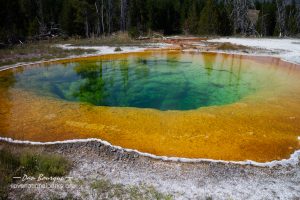
At the end of the boardwalk trail in the Upper Geyser Basin is Morning Glory Pool, one of the most colorful in the park. Comparing pictures from 24 years ago and now, the pool seems to have shifted in color from turquoise to more green
The best times to visit the main areas are early (before 10AM) and late (after 5PM) when the crowds are fewer. Plan your days to visit one main area early, spend midday at some of the lesser known area, and go back to a busy area after dinner. You’ll still hit crowds, but far less than you would if you tried to visit a major area midday.
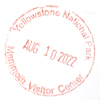 Use the bathroom when you can. While there are plenty in the park, the map we got at the entrance DID NOT have them marked, and sometimes they were missing in places where you expected them. For instance, there were no bathrooms in three consecutive and popular parking areas along the Firehole River–bathrooms were absent from Fairy Falls Trailhead, Biscuit Basin, and Black Sand Basin forcing us to try to get into the busy areas of Old Faithful and Grand Prismatic Spring when nature called.
Use the bathroom when you can. While there are plenty in the park, the map we got at the entrance DID NOT have them marked, and sometimes they were missing in places where you expected them. For instance, there were no bathrooms in three consecutive and popular parking areas along the Firehole River–bathrooms were absent from Fairy Falls Trailhead, Biscuit Basin, and Black Sand Basin forcing us to try to get into the busy areas of Old Faithful and Grand Prismatic Spring when nature called.
Don’t worry too much about finding the wildlife, they’ll find you, especially the bison. Bear sightings, while regular, are certainly not guaranteed. News of bear sightings travels fast, so if you see 100 cars and people all parked on the side of the road, chances are there’s a bear to be seen nearby. Just stop safely OFF the road and see what the fuss is all about. You will also see a lot of crazy driving like people crossing double yellow lines as they stare at something off the road, so stay alert.
Just a warning, one of the things that never comes through in pictures is the smell of Yellowstone! When you first hike out to a geyser basin, your nose is assaulted with a strong sulfur smell. After a while, you get used to it and it doesn’t bother you, but just be prepared.
Stories Sorry, This Car is Full!
Nearby Towns West Yellowstone (Idaho), Gardiner (Montana), Pahaska, Jackson, Cody (Wyoming)
Other Nearby Attractions Grand Teton NP, Jackson Hole Ski Area, Grand Targhee Ski Area, Snow King Ski Area, Snake River (white water rafting)
Official NPS Website Yellowstone NP
ILNP Photo Map
- Here it is, the star of the park, Old Faithful Geyser. It’s one of the things you simply must see if you’re there (it erupts approximately every 90 minutes), but the ever-present crowd distracts a bit from its beauty
- The Upper Geyser Basin, home to Old Faithful, is the “crown jewel” of Yellowstone–the boardwalk trail takes you near several geysers including Castle Geyser seen here during a minor eruption
- Only a few of the geysers in Yellowstone are predictable enough to make the “timetable” of posted eruption times, and at least four of those are in Upper Geyser Basin including Daisy Geyser which sprayed hard enough to get the crowd wet just out of camera to the right
- At the end of the boardwalk trail in the Upper Geyser Basin is Morning Glory Pool, one of the most colorful in the park. Comparing pictures from 24 years ago and now, the pool seems to have shifted in color from turquoise to more green
- One of the “scheduled” geysers in the Upper Geyser Basin is Riverside Geyser on the edge of the Firehole River. It’s well worth watching, especially since it erupts for around 20 minutes at a shot and is one of the more scenic geyser locations
- The geysers all have unique shapes and personalities like the cartoonish “face” of Grotto Geyser in Upper Geyser Basin
- Outside view of the unique landmark of the Old Faithful Inn, still an active hotel right next to Old Faithful and the Upper Geyser Basin
- Since you’re already going to stop and watch Old Faithful, its worth a couple minutes to peek inside the Old Faithful Inn, which I describe as the world’s largest log cabin (not sure if that’s accurate, but it seems like it)
- To really see the colors of Grand Prismatic Spring, you need a bit of elevation. The trail to Fairy Falls provides such a vista with a moderate 1.5 mile round-trip hike
- Grand Prismatic Spring in the Midway Geyser Basin is one of the most popular spots in the park. A boardwalk gets you close to the spring, but it’s difficult to see the colors from ground level
- While ground level at Grand Prismatic Spring doesn’t reveal the color well, it does give you a great view of the unique ridged pool structure surrounding the main pool with turquoise-reflecting steam rising up from the pool behind
- The aptly named “Firehole River” runs through the Upper, Midway and Lower Geyser Basins. Streams of steaming water run down to it from nearby geysers and pools including these two cascades from Grand Prismatic Spring
- The smaller geyser basins in Yellowstone still have sights worth seeing and are a great place to get away from the crowds. This colorful pool known as Black Diamond Pool is in Biscuit Basin between the Upper and Midway Geyser Basin areas
- The clear Sapphire Pool at Biscuit Basin–it’s amazing how each pool is truly unique in its shape, color and clarity, and pools adjacent to one another can be completely different
- The Fountain Paint Pot Trail is a boardwalk through the Lower Geyser Basin. While it isn’t home to the most spectacular features, it’s a great concentration of colorful pools, paint pots, and small but active geysers that’s less crowded than the Upper and Midway Geyser Basins
- The Fountain Paint Pots in the Lower Geyser Basin are fun to watch–it looks like boiling pudding, and the popping bubbles take on many shapes
- Some geysers are more active than others, and we saw Clepsydra (or possibly Spasm Geyser–they’re right next to each other) Geyser in the Lower Geyser Basin erupt for several minutes during both our visits
- This beautiful tiered waterfall is along the Grand Loop Road between Golden Gate and Mammoth
- One of the neatest views in the Mammoth Hot Springs area is that of New Blue Spring from the boardwalk near the Upper Terrace Area–this view lets you see the beautiful turquoise water that sits atop the white and orange formations
- Mound Spring, located between the Lower and Upper Terrace areas, is one of the most colorful terraced springs in the area, though it requires a hike of many stairs to reach
- This view of Mound Spring shows how the formations are tucked into the rocks and surrounded by pools
- The geologic features near Mammoth Hot Springs are completely different from those further south in the park. These terraces range in size, and one of the largest and most accessible is Palette Spring seen here
- Mammoth Hot Springs, on the northern edge of the park, was the first area developed. The stone buildings of Fort Yellowstone housed an Army unit that kept order in the area for a while. The old bachelor officer’s quarters here now serves as the Visitor Center
- Obsidian Cliff, on the road to Mammoth Hot Springs, highlights an area where Native Americans would harvest bits of obsidian to use or trade
- The Norris Geyser Basin isn’t as famous as the Upper Geyser Basin, but its substantial in its own right and worth a walk around at least one of the two boardwalk trails. This one is Porcelain Basin on the north side
- When I first visited Yellowstone in the late ’90s, signs lamented how vandalism has caused Steamboat Geyser, the tallest in the park, to go dormant. 20 years later, Steamboat had come back to life, and while large eruptions were only occuring a couple times a month, it was good to see it spouting water again during a very minor eruption
- The West Thumb Geyser Basin is a smaller geothermic area that’s neat to visit because it contains pools, geysers and mud pots and sits right on the shore of Yellowstone Lake
- One of the more unique geothermal features is Fishing Cone in West Thumb Geyser Basin which rises up from Yellowstone Lake
- Gibbon Falls lies between Madison and Norris and is well worth the brief stop and walk to the overlooks. I wish I had a person in this picture for scale as the falls are larger than they look here
- The wide Hayden Valley between Fishing Bridge and Canyon Village is one of the best places to consistently see wildlife in the park. While not in this photo, we saw many bison on the south end of the valley
- Any of the larger animals (bears, bison, elk) will cause a traffic jam at Yellowstone such as the bison jam here at the southern end of Hayden Valley. Everyone slows down, but please be courteous and don’t stop ON the road unless the animal is physically keeping you from moving
- One of the more unique views in the Grand Canyon of the Yellowstone is the Upper Falls Viewpoint from the south rim
- Artists Point, at the end of the South Rim Drive, is a great place to get a sweeping view of the Grand Canyon of the Yellowstone and Lower Falls
- There are amazing views of the Grand Canyon of the Yellowstone and both Upper and Lower Falls along the north and south rims, but we preferred the south rim including this zoomed in shot from Artists Point
- You can get to the brink of both the Upper and Lower Falls. The Lower Falls is taller and more dramatic, but its also a substantial hike to the rim. The rim of the Upper Falls, accessible on the north rim side, is a very short and easy hike
- Mount Washburn offers panoramic views of the park, and it can be reached by three trails. This is the trailhead for one of the trails accessible by a dirt road, but I would choose the trailhead further south that climbs through the forest
- Tower Falls lies near Tower-Roosevelt in the northeast section of the park. A parking area near the general store offers both a short hike to this overlook and a longer hike to the bottom. We didn’t have time for the long hike, but the short hike was well worth it
- Who doesn’t want to see the Mud Volcano? Like its name implies, it spits and spews muddy hot water and steam
- Dragon Mouth Spring, next to the Mud Volcano near Fishing Bridge, was one of the surprisingly cool geothermic features. True to its name, steam continually erupts from a cave making a range of loud hissing noises that are worth the quick stop to view
- The bison have the right of way at Yellowstone and use it freely! August is mating season, and the bison tend to be more active but also more aggressive. This is along the road to the Northeast Entrance near Tower
- The bison in Yellowstone roam the park, but we found herds at Hayden Valley and in Lamar Valley east of Tower as seen here
- The bison are fun to watch from a safe spot, especially when they do things like taking a dust bath
- A dirt road along the Northeast Entrance Road takes you to Slough Creek, home of a campground, serene scenery and the occasional bison or bear
- The overlook on Lake Butte off the East Entrance Road offers a commanding view of Yellowstone Lake
- While the center of the park is Yellowstone Lake, other lakes are easily accessible including Lewis Lake between the South Entrance and Grant Village seen here at sunset on a stormy evening
- Those driving between Yellowstone and Grand Teton National Parks will drive along the rim of Lewis Canyon. It’s frustrating because where there are amazing views, there are no turnouts or parking areas, and where there are parking areas, the views are obscured as they are here
Write Your Own Review

